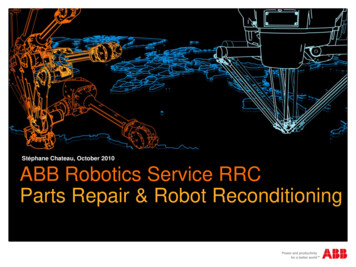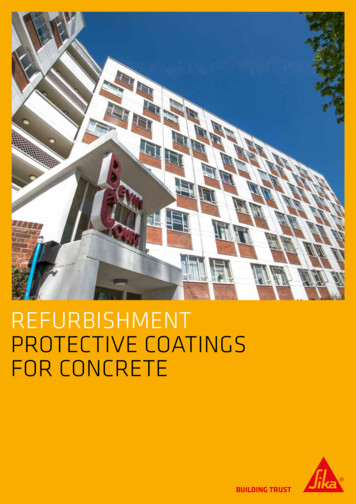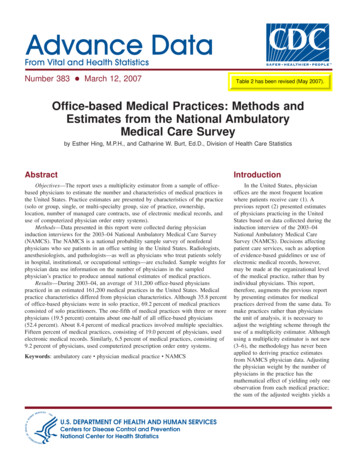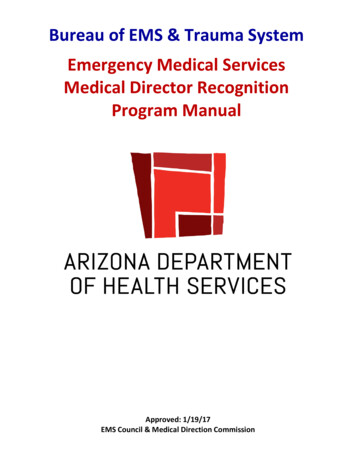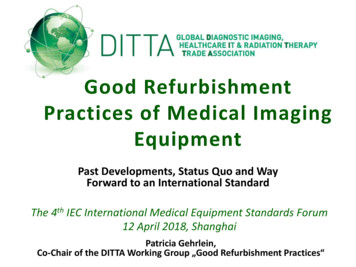
Transcription
Good RefurbishmentPractices of Medical ImagingEquipmentPast Developments, Status Quo and WayForward to an International StandardThe 4th IEC International Medical Equipment Standards Forum12 April 2018, ShanghaiPatricia Gehrlein,Co-Chair of the DITTA Working Group „Good Refurbishment Practices“
Structure of Presentation Preface: DITTA & the Working Group on Good Refurbishment PracticesPast Developments: From GRP to IEC PAS 63077Status Quo: IEC PAS 63077Status Quo: From IEC PAS 63077 to IEC 63077Status Quo: IEC WG53 Medical Imaging EquipmentWay Forward: From IEC PAS 63077 to IEC 63077
Preface (1/5):DITTA DITTA is the Global Diagnostic Imaging, Healthcare IT & Radiation TherapyTrade AssociationDITTA is a non-profit trade association, created in 2000 and incorporated in2012 represents more than 600 companies around the globe.DITTA covers the following industry sectors:1. Diagnostic imaging2. Radiation therapy3. Healthcare IT4. Electromedical5. and RadiopharmaceuticalsThese industry sectors lead in state-of-art advanced technology andprovides integrated solutions covering the complete care cycle
Preface (2/5):DITTA Global Presence
Preface (3/5):DITTA GovernanceBoard of DirectorsDITTA Chair: Patrick Hope, MITA Executive DirectorDITTA Vice-Chairs: Nicole Denjoy, COCIR Secretary General Satoshi Kimura, JIRA Executive DirectorSteering CommitteeChair: DITTA ChairMembers: Heads of each organization Leadership of their International Groups Leadership of DITTA WGsTCONs: one per monthMembers: Founding Organizations Executive Management of each organization Chairs of their International GroupsWorking GroupsChair: One Chair, Two Vice-Chair per Working GroupMembers: Mixture of trade associations and company experts Coordination: MITA , COCIR or JIRATCONs: as needed
Preface (4/5):9 DITTA Working Groups1.Regulated Product Submission (RPS)Working Group2.Standardisation (STA) Working Group3.Unique Device Identification (UDI)Working Group4.Medical Device Single Audit Program(MDSAP) Working Group5.Medical Software (MSW)Working Group*16.Global Health (GH) Working Group7.Environmental Policy (ENVI) WorkingGroup8.Good Refurbishment Practice (GRP)Working Group9.Cybersecurity Working GroupMDSAP RAC(Regulatory Authority Council)6
Preface (5/5):DITTA Good RefurbishmentPractices (GRP) Working Group Chair:o Michael Schmit, GE HealthcareCo-Chairs:o Jeroen van Nistelrooij, Philips Healthcareo Patricia Gehrlein, Siemens HealthineersSecretary:o Susumu Uchiyama, JIRAMembers from the following organizations are active in the GRP working group:
Remanufacturing &Refurbishment in the medicalequipment industries Remanufacturingo Outside the medical equipment industries the terms remanufacturing and refurbishment are often used as synonyms.o Within the medical equipment industries we have to consider the term remanufacturer as defined by the U.S. Foodand Drug Administration:– In the USA, the Food and Drug Administration defines ‘remanufacturer’ as “( ) any person who processes,conditions, renovates, repackages, restores, or does any other act to a finished device that significantly changesthe finished device's performance or safety specifications, or intended use.” (CFR 21 Part 820)o This means that in the medical equipment industries there are differences between refurbishment andremanufacturing. The most important aspect is: for refurbished medical (imaging) equipment there is no significantchange of the performance or safety specifications, or in the intended use of the equipment compared to thespecifications the manufacturer defined for the relevant new equipment.o In the EU, there is no official definition of remanufacturing. The term is used by other industry sectors with differentmeanings. Refurbishmento According to IEC 63077 PAS and NEMA/MITA 1-2015 refurbishment of a medical imaging equipment is defined as:“process or combination of processes applied during the expected service life to restore used medical imagingequipment to a condition of safety and effectiveness comparable to when new.Note 1 to entry: Refurbishment can include activities such as repair, rework, replacement of worn parts, andupdate of software/hardware but shall not include activities that result in regulatory submissions.”
Past Developments (1/2):From GRP to IEC PAS 63077 In 2007, COCIR published the principle of “Good RefurbishmentPractices” (GRP) as a Green Paper, followed by a “GoodRefurbishment Practices Industry Standard” document in 2009.In 2009, the industry associations COCIR (EU), JIRA (Japan) andMITA (USA) released a joint “Good Refurbishment Practices”Green paper filling a need in the global healthcare market forsafe and effective refurbished medical devices.In 2010, this activity has further resulted in the transfer of theworking group on “Good Refurbishment Practices” (GRP) atCOCIR to the global medical imaging devices association DITTA.The feedback to the COCIR industry standard triggered the ideawithin the DITTA GRP working group to further develop aninternational standard on GRP.
Past Developments (2/2):From GRP to IEC PAS 63077 From 2014 to 2015 the DITTA GRP working group completely reworkedthe COCIR industry standard. With the support of DITTA, the US-basedindustry association MITA managed to develop and publish the outcome of this rework as NEMA/MITA 1-2015 standard in February 2016.At the same time, in 2016, DITTA released an updated Green Paper onthe GRP. The Green paper describes how the standard might be applied.In addition, DITTA (via MITA) collaborated with ANSI (American NationalStandards Institute) to file a request to the InternationalElectrotechnical Commission (IEC) to publish the content ofNEMA/MITA 1-2015 standard as an IEC PAS.A Publicly Available Specification (PAS) is a standardization documentin a preliminary stage to an IEC standard. The objective of a PAS is tospeed up standardization. PASs are often produced in response to anurgent market need.Later in 2016, IEC published IEC PAS 63077 – content wise identical toNEMA/MITA 1-2015.
Status Quo: IEC PAS 63077Main Objective & BenefitsWhy do we need an international standard on good refurbishment practices formedical imaging equipment? Ensuring safety and effectiveness of the refurbished medical devices: Safety andeffectiveness are the most important aspects to consider with medical imaging devices,including refurbished devices. By collecting the best practices from across industry andregulatory agencies and documenting the state-of-the-art processes this standard can ensurethat all entities complying with it meet these appropriate levels of controls to ensure safetyand effectiveness.What are the benefits of refurbishment of medical imaging devices? There are benefits for the environment and the economy as well as for patients, hospitals andsociety that result from refurbishing medical devices.
Status Quo: IEC PAS 63077Benefits Good for the Environment: Refurbishment reduces waste generation and saves energy,resources and raw materials.o By minimizing the production of new parts for the devices, refurbishment contributes to save energy. DITTA estimates thataround 30 MWh can be saved for each ton of refurbished medical devices.o DITTA estimates that in 2012 around 16.400 tons of used medical devices have been prevented from becoming waste,instead being shipped world-wide for refurbishment and repair. Europe and Unites States account for most of therefurbishment activities worldwide. Good for the Economy: Refurbishment extends the economic life of medical devices andcontributes to new jobs, growth and investment.o According to DITTA, the refurbishment of medical devices accounted for a global revenue of approximately 480 millioneuros in 2012. Approximately 74% of all refurbished medical devices are sold in both the U.S. (48%) and the EU (26%). Good for Patients, Hospitals & Society: Refurbished medical devices can be sold for a lowerprice than new medical devices. Therefore, refurbishment strongly contributes to increasedaccess to affordable and high-quality healthcare.o In current times of constrained budgets, refurbished medical devices help hospitals and medical centers with budgetrestrictions to purchase high-quality devices and substitute their used devices.o By substituting used, outdated devices with refurbished medical devices, the overall quality of healthcare for patients canbe improved, e.g. by providing better diagnosis, which allows for better therapy and increasing chance of survival; byreducing radiation exposure thanks to latest features; by ensuring faster diagnosis and improving patient comfort.
Status Quo: IEC PAS 63077Content Overview1. Foreword2. Scope3. Normative References3. Terms and definitions4. General requirements forrefurbishment of used medicaldevices5. Specific requirements forgood refurbishment practice3.1 expected service life3.2 intended use/intended purpose3.3 manufacturer3.4 medical imaging equipment3.5 normal use3.6 operator3.7 refurbisher3.8 patient3.9 process3.10 refurbishment3.11 repair3.12 rework3.13 risk3.14 used medical imaging equipment4.1 Quality management system4.2 Resource management4.3 Corrective and preventive action4.4 Customer complaints4.5 Production and service provision4.6 Control of non-conforming product4.7 Post-market surveillance process4.8 Document control4.9 Purchasing4.10 Control of design and design changes5.1 General5.2 Selection of medical imagingequipment for refurbishment5.3 Evaluating market accessrequirements5.4 Preparation for refurbishment,disassembly, packing, and shipment5.5 Planning5.6 Installation of safety updates(hardware/software)5.7 Performance and safety test5.8 Packing, shipment, and installation ofrefurbished medical imaging equipment5.9 Record of refurbishment5.10 Refurbishment label
Status Quo: IEC PAS 63077Definition of Refurbishment According to IEC 63077 PAS, article 3.10 refurbishment:“process or combination of processes applied during the expected service life to restore usedmedical imaging equipment to a condition of safety and effectiveness comparable to whennew.Note 1 to entry: Refurbishment can include activities such as repair, rework, replacement ofworn parts, and update of software/hardware but shall not include activities that result inregulatory submissions.”
Status Quo:From IEC PAS 63077 to IEC 63077 In 2017, DITTA (via MITA and ANSI) filed a request via a new work item proposal (NWIP) to IECSC62B to set up an IEC working Group on GRP to transfer the IEC 63077 PAS into IEC 63077standard.In January 2018, the NWIP was approved with 94.7% of positive votes in IEC SC62B.As a result, WG53 “Refurbishment of Medical Imaging Equipment” was created.
Status Quo: IEC WG53 of MedicalImaging Equipment Reports to the Subcommittee (SC) 62B “Diagnostic Imaging Equipment”, which reports to theTechnical Committee (TC) 62 “Electrical Equipment in Medical Practice” (Secretary for both:Norbert Bischof)Has launched its activities on 28 February 2018 in a meeting in ViennaActing Convener: Dr. Markus Braun, Siemens HealthineersFirst nameNCLast nameFirst nameNCMembers: Last lKi-YoungZhiyongShojiSusumuJPATUSITUSKRCNJPJP
Way Forward (1/2):From IEC PAS 63077 to IEC 63077 WG 53 will propose to circulate a “Committee Draft for vote” (CDV) as next draft, subject toapproval by SC 62B.o WG 53 believes that IEC PAS 63077 can be a CDV after revising reflecting effectivecomments received with the vote on the 62B/1071/NP.o The draft distributed with the 62B/1071/NP is based on IEC PAS 63077 (2016) and it isreferring to the NEMA standard NEMA/MITA 01-2015.o WG 53 reviewed and discussed the observations to the comments and decided to revise therequirements referring to the observations we agreed during the meeting and believes thatthe next step should be CDV, i.e. skipping the “Committee Draft” (CD).
Way Forward (2/2):From IEC PAS 63077 to IEC 6307719 January:Approval ofthe NWIPMarch:Regular alignmentcalls of WG53 Report to SC62B28 Feb / 1 March:Kick-Off meetingWG 53ProposalStage May & June:Translation of CDVinto French April:Finalization of CDVand review by TC62BSecretaryPreparatory & CommitteeStageNWIP approved if : a simple majority of the committee’s Pmembers approve the new work item and if the minimum number of experts arenominated by P-members’ approving thenew work item proposal. For committeeswith 16 or less P-members, a minimum of 4experts and for committees with 17 or moreP-members, a minimum of 5 experts. October:Comment review &meeting for the resolutionof comments to the CDV July/August/September:Circulation of CDV tomembers of TC62B forreviewEnquiry StageCDV approved if: a majority of two thirds ofthe votes cast by P-membersis in favor, and if the number of negative votescast by all NationalCommittees does not exceedone quarter of all votes cast. 2019: Publicationof IEC 63077 November/December:voting periodfor FDISApprovalStagePublicationStageFDIS approved if: 2/3 majority of Pmembers votingapprove and if Less than 25% ofall votes submittedare negative.Publication within1.5 months ofapproval of the FDIS
Good Refurbishment Practices ofMedical Imaging Equipment:Main Take Away’s Refurbishment of medical imaging equipment is conducted since about two decades by severalmedical equipment companies.Aiming at finalizing the development of an international standard, IEC 63077 “Goodrefurbishment practices for medical imaging equipment”, ensures the safety and effectivenessof the refurbished medical imaging equipment.Refurbishment of medical imaging equipment has benefits for the environment, the economyas well as patients, hospitals and society.The global medical imaging association DITTA has triggered the idea to have this internationalstandard and is further dedicated to promote the use and market access of refurbished medicalimaging equipment.Currently, IEC WG53 is finalizing the standard by developing from a Publicly AvailableSpecification (PAS) to an international standard.
Contact DetailsGood RefurbishmentPractices of MedicalImaging EquipmentPatricia GehrleinPast Developments, StatusQuo and Way Forward to anInternational Standard Senior Policy Advisor forRefurbished Systems,Government Affairs & Policy,Siemens HealthineersThe 4th IEC International MedicalEquipment Standards Forum12 April 2018, Shanghai E-Mail:patricia.gehrlein@siemenshealthineers.com Co-Chair of the DITTA WorkingGroup „Good RefurbishmentPractices“
Practices _ (GRP) as a Green Paper, followed by a Good Refurbishment Practices Industry Standard document in 2009. In 2009, the industry associations COCIR (EU), JIRA (Japan) and MITA (USA) released a joint Good Refurbishment Practices Green paper filling a need in the global healthcare market for safe and effective refurbished medical devices.
